Customer feedback tools help you understand your customers’ thoughts and turn those insights into measurable business growth.
The right tools allow you to spot problems early and improve your products based on real customer needs. With a more customer-centric approach, you’ll quickly build stronger relationships with those who buy from you.
In this guide, you’ll find the best customer feedback tools for small businesses and learn how to choose the right one. You’ll also get practical tips for collecting feedback and using those insights to increase sales.
Key takeaways from customer feedback tools
Customer feedback tools range from simple survey builders to comprehensive platforms that monitor reviews, analyze sentiment and track conversations across multiple channels.
The most significant benefit is turning scattered customer opinions into actionable data that directly improves your products, reduces churn and identifies upselling opportunities.
Free plans work for basic testing, but most businesses need paid features like unlimited responses, CRM integration and advanced analytics to scale effectively.
Pipedrive's workflow automation connects with leading feedback tools to automatically create follow-up tasks when customers submit responses. Start your 14-day free trial to see how customer insights can drive more sales.
6 types of customer feedback software
Customer feedback software helps you collect, organize and analyze what your customers think about your business. It makes it easy to gather opinions through surveys, reviews, direct messages and more, then turns that data into actionable customer insights.
That’s why tracking customer feedback is essential, especially for small and medium businesses (SMBs), where every customer relationship impacts the bottom line. It helps you understand what’s working and what isn’t, so that you can boost sales.
Here are the main types of feedback software and what to look for in each:
Customer feedback software | How you can use it |
1. Customer survey tools | Create and send questionnaires to customers.
|
Monitor and respond to online reviews.
| |
3. Live chat feedback | Collect real-time feedback on website features.
|
4. Email feedback tools | Send feedback requests through email campaigns.
|
5. Website feedback analytics | Add feedback forms to your responsive website.
|
6. All-in-one customer feedback platforms | Combine multiple feedback methods in one tool.
|
The right type of feedback tool depends on how your customers prefer to communicate and where you most need their input. Many small businesses start with one kind and add others as they grow.
11 best customer feedback tools in 2025
The right feedback software does more than gather opinions. It can reduce customer churn and build customer loyalty.
Here are the best customer feedback tools for improving customer support and driving repeat sales through lasting relationships.
1. SurveyMonkey
SurveyMonkey is an online platform for building, sharing and analyzing surveys. It helps businesses collect feedback, conduct market research and gather employee insights through different survey types and question formats:
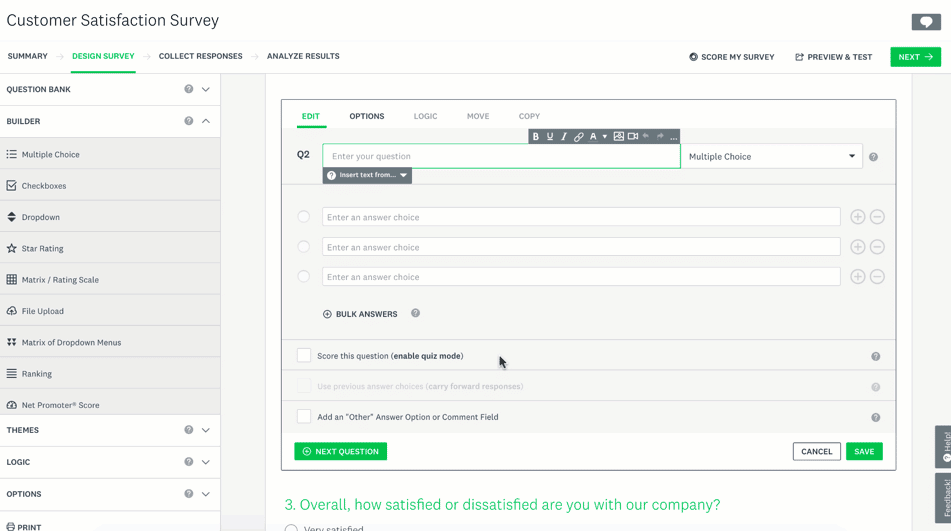
SurveyMonkey’s free plan lets you create unlimited surveys for things like product feedback, but it limits you to 10 questions and only allows you to view up to 25 responses per survey. It works well for general feedback collection across teams, such as measuring customer satisfaction.
How businesses use SurveyMonkey:
Collect basic feedback or run quick polls for free, as long as you don’t need to see more than 25 responses (Free plan)
Choose from 500+ templates for customer satisfaction, product feedback and market research (Free plan)
View responses and export customer data as a PDF or spreadsheet for analysis (Standard Monthly plan)
Remove SurveyMonkey branding from your surveys and use advanced features like A/B testing questions (Advantage Annual plan)
Collaborate with team members and control who can view, edit and comment on survey results (Team Advantage plan)
Use AI to build surveys and identify patterns in responses (all paid plans)
The free plan works for basic testing, but serious customer feedback collection requires a paid plan to access all response data and remove branding.
Note: SurveyMonkey connects with Pipedrive through automation platforms like Zapier and Make. Once connected, it automatically creates deals for leads or updates customer data as survey responses come in.
2. Typeform
Typeform is a tool for creating forms and surveys that ask one question at a time, making the experience more like a conversation. This interactive style can help increase completion rates.
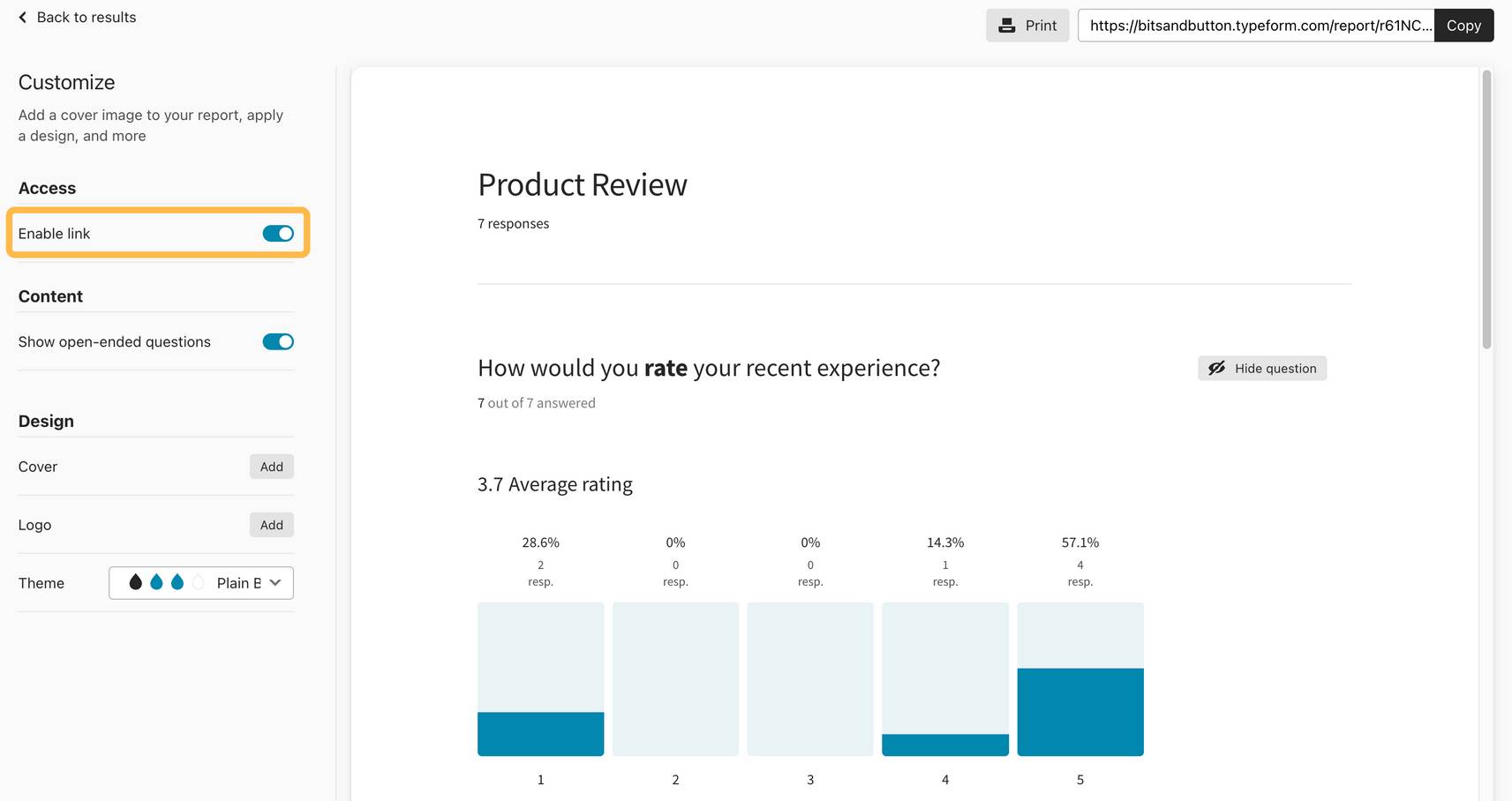
It helps create engaging forms that make a good impression, like lead capture forms or welcome email questionnaires. The free plan offers unlimited forms but caps you at 10 responses per month.
How businesses use Typeform:
Create a simple contact or registration form with basic branding (Free plan)
Use conditional logic to show different questions based on a customer’s answers (Free plan)
Collect up to 100 responses per month and access basic integrations (Basic plan)
Remove Typeform branding, add your logo and use custom subdomains with up to 1,000 responses monthly (Plus plan)
Access advanced analytics and support up to 10,000 responses monthly with priority support (Business plan)
Typeform creates a substantial visual impact and interactive customer experiences. The free plan is relatively limited, so businesses should use a paid plan for ongoing customer feedback.
Note: Typeform integrates with Pipedrive through Zapier and offers a direct integration with Pipedrive, creating new deals when someone fills out your form. You can map form responses to specific Pipedrive fields and choose which pipeline stage to send new leads to.
3. Jotform
Jotform is an online form builder with features beyond simple surveys, including payment processing, e-signatures and data management.
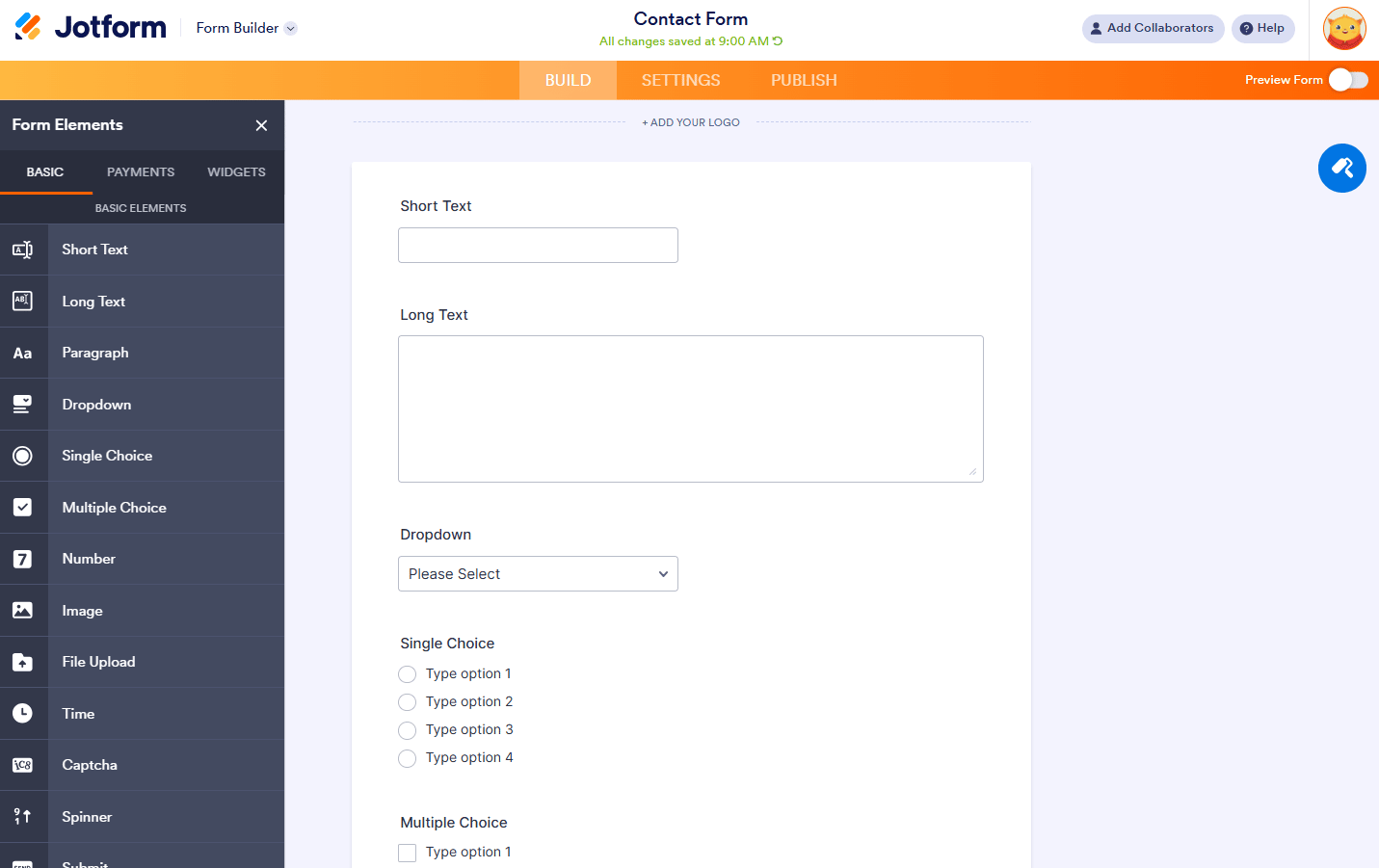
It’s a cloud-based, no-code solution that allows you to create custom forms by dragging and dropping elements from various form fields.
Jotform is helpful for different types of data collection, not just feedback. The free plan offers up to five forms, with 100 monthly submissions and 100 MB of storage space.
How businesses use Jotform:
Create almost any type of form using a library of over 10,000 templates (Free plan)
Collect up to 10 payments or 100 e-signatures per month without a paid subscription (Free plan)
Get more monthly submissions (1,000) and remove Jotform branding from your forms (Bronze plan)
Access 50 forms, 2,500 monthly submissions and 10 GB storage (Silver plan)
Gain HIPAA compliance functionality for handling sensitive healthcare information (Gold plan)
Use the Jotform API to build custom integrations with your business software (Enterprise plan)
Jotform’s free plan makes it a solid tool for startups and small businesses needing versatile operations, sales and feedback forms. Its compliance features make it worthwhile for healthcare companies.
Note: Jotform offers direct integration with Pipedrive. You can select which pipeline, stage and owner to assign new deals, and map form fields to Pipedrive fields. Jotform also supports prefilling forms with data from Pipedrive’s CRM for a better user experience.
4. Survicate
Survicate is a customer feedback solution that runs surveys on your website, inside your mobile app or through email. It lets you gather feedback right at the moment a customer is interacting with your product or service:
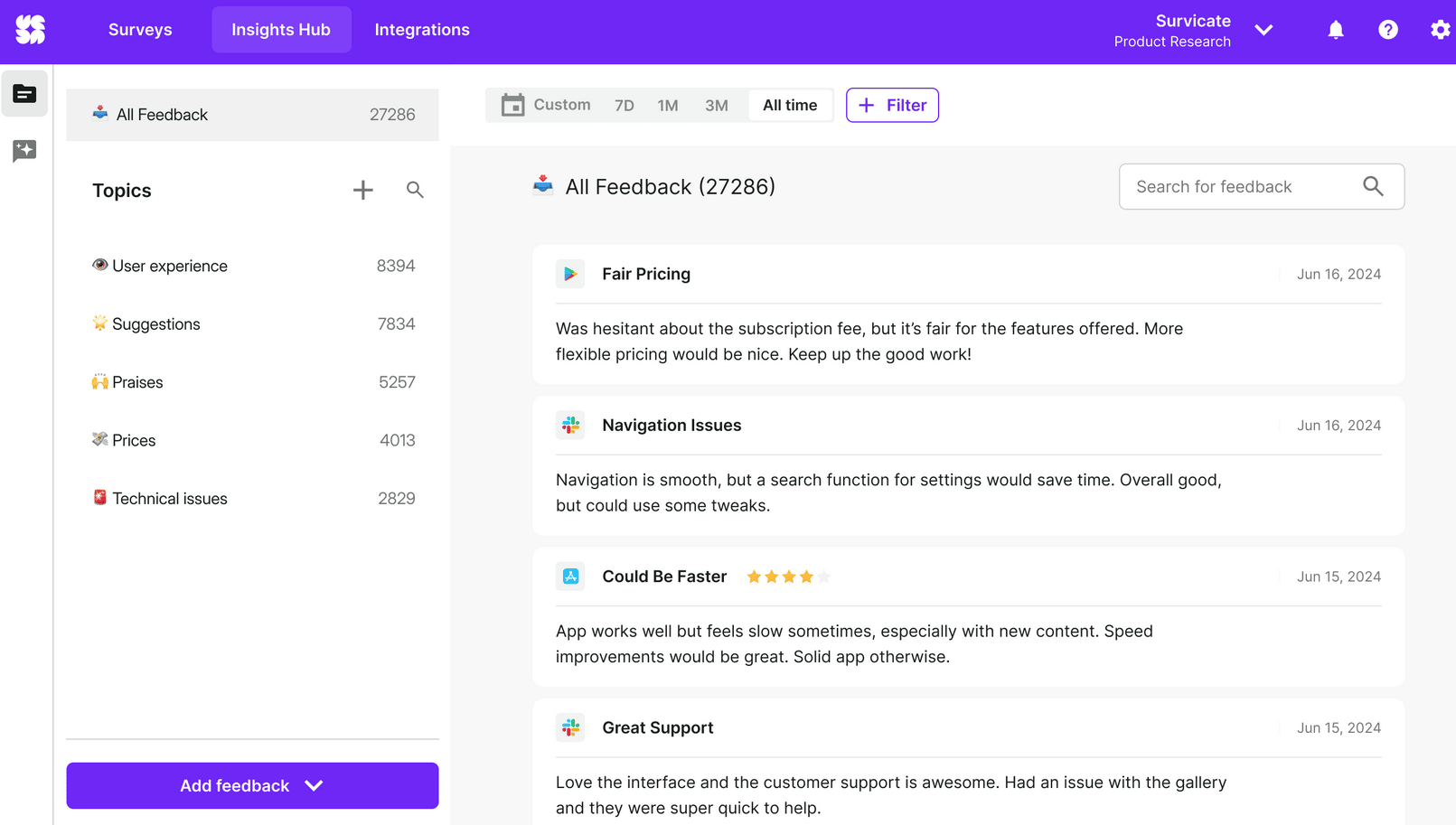
Asking users about a specific feature right after using it makes the feedback more accurate across the entire customer journey.
How businesses use Survicate:
Run one website or in-app survey at a time and collect up to 25 responses per month (Free plan)
Track customer engagement with net promoter score (NPS) surveys, measure delight with customer satisfaction score (CSAT) surveys and gauge effort with customer effort score (CES) forms (Free plan)
Sync responses to your CRM for sales use cases (Free plan)
Add your branding and get survey-level analytics and visual reports (Starter plan)
Get unlimited surveys, recurring user feedback, advanced targeting and team collaboration (Growth plan)
Use AI-powered tools to find advanced insights, like sentiment and automatic feedback analysis (Growth plan)
Survicate helps get specific types of feedback and gauge customer sentiment. The free plan offers useful features, but limited responses mean you’ll likely need to upgrade quickly.
Note: Survicate integrates with Pipedrive through Zapier. The user-friendly integration creates feedback notes in Survicate’s Feedback Hub and updates customer profiles with survey responses.
5. Google Forms
Google Forms is a free tool for creating simple forms and feedback surveys. It’s part of the Google Workspace suite and can support questions like multiple choice, open-ended and Likert scales.
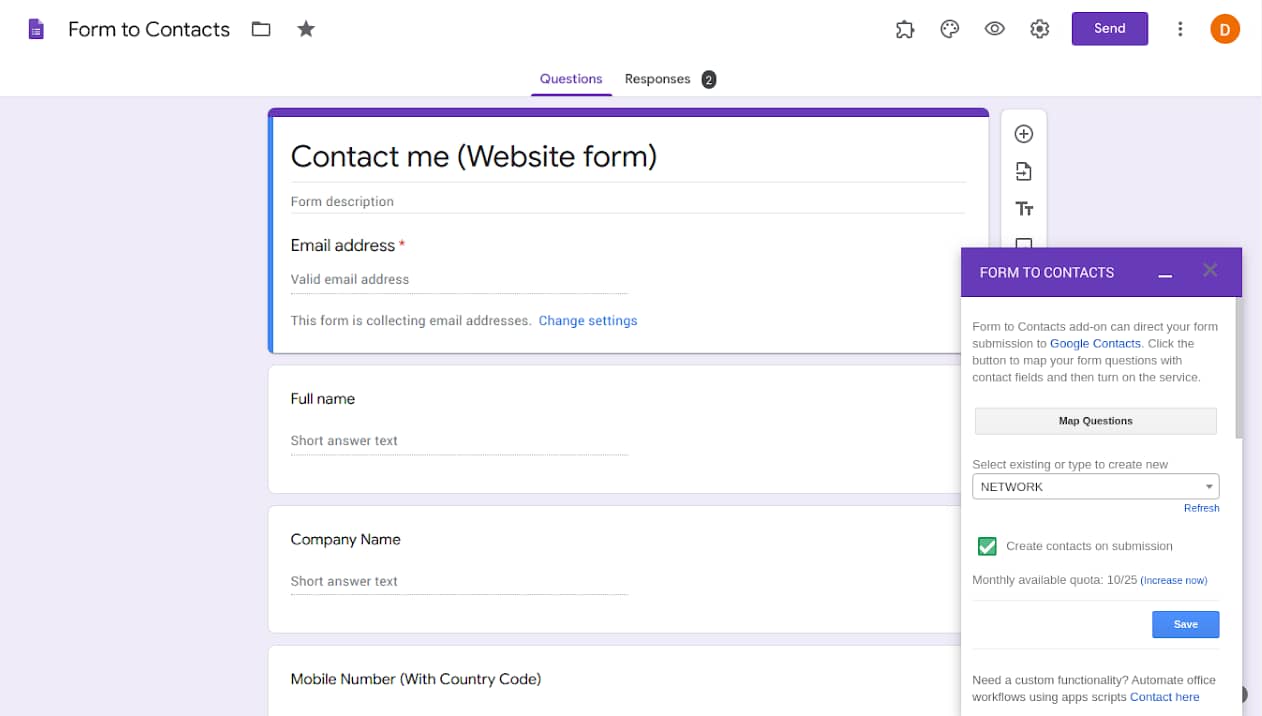
Google Forms is for businesses or individuals who need a functional way to gather information at no cost. It’s useful for internal team surveys, simple event RSVPs or basic customer feedback forms where budget is the primary concern.
How businesses use Google Forms:
Create unlimited surveys with unlimited questions and collect unlimited responses for free
Automatically send all responses to a Google Sheet for easy sorting, filtering and analysis
Add collaborators to let multiple team members build and edit a form together
Use basic skip logic to send users to a specific section based on their answer (limited to dropdown and multiple-choice questions)
Embed forms directly onto a webpage or send a link via email
Google Forms provides straightforward data collection. While it doesn’t offer many question types or advanced reporting features, its free availability and syncability with other apps make it worthwhile for small businesses with a small budget.
Note: The Google Workspace integrates with Pipedrive directly. You can keep customer contact details, questionnaires and events synced between your CRM and Google’s apps.
6. Zonka Feedback
Zonka Feedback is a customer experience platform that lets you collect multi-channel feedback:
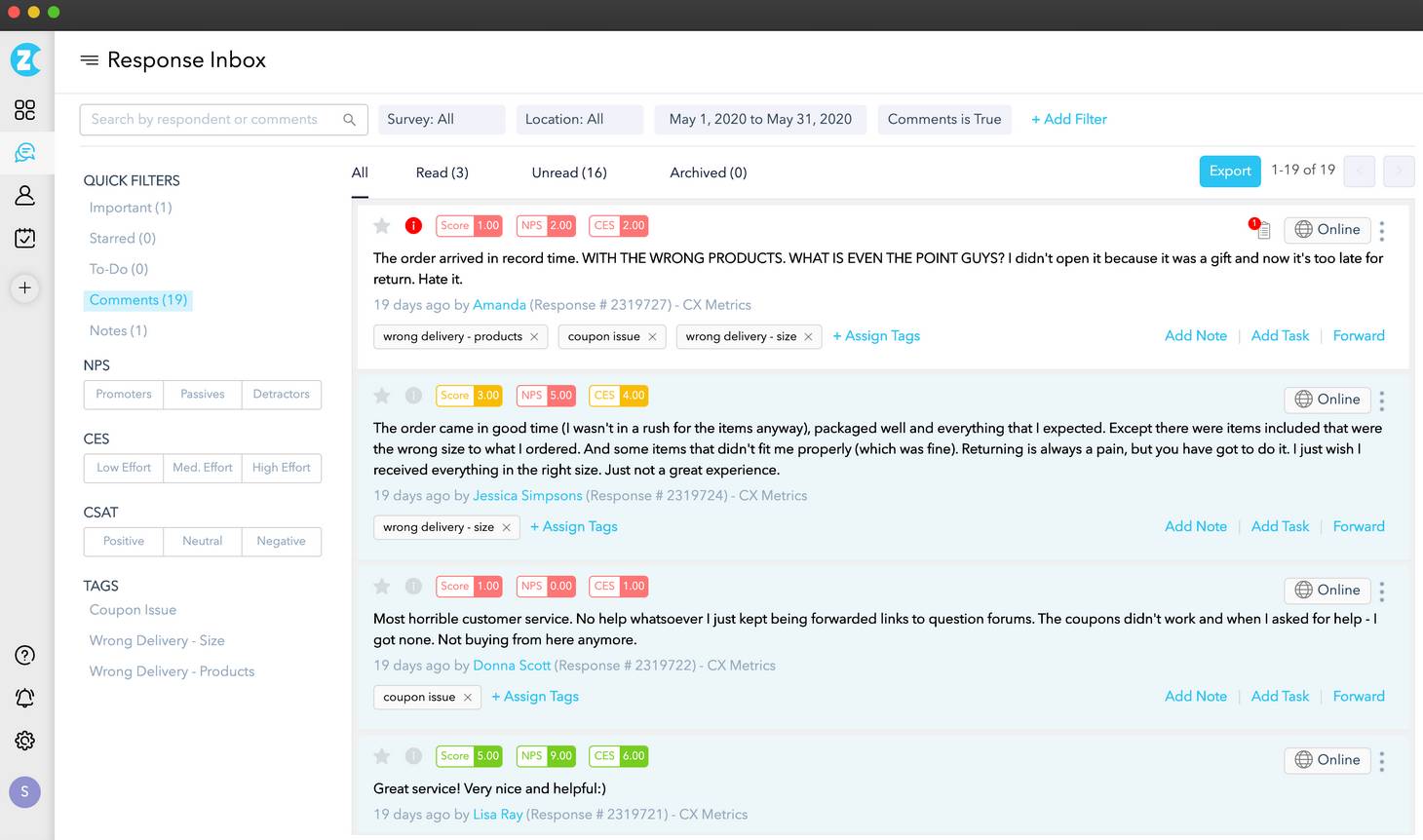
It captures experiences and feedback at all touchpoints, including in-person, offline, online, through email and mobile SMS. It also provides a space for active listening.
A key feature is its ability to run surveys on tablets or smartphones in kiosk mode, meaning you can capture feedback on-site without an internet connection.
How businesses use Zonka Feedback:
Collect up to 25 responses per month across web, email and links (Free plan)
Create surveys to measure key marketing metrics like NPS, CSAT and CES (Free plan)
Get more responses and use more offline devices for on-site feedback (Starter plan)
Remove Zonka Feedback branding and trigger surveys via SMS or QR codes (Professional plan)
Automate actions by integrating with CRMs to create tickets or send notifications based on feedback (Professional plan)
Zonka Feedback captures omnichannel feedback, meaning you’ll only need one tool. Combined with a CRM like Pipedrive, it provides almost everything you need to track and supply your customers’ needs.
Note: Zonka Feedback integrates natively with Pipedrive. You can trigger surveys to contacts for existing deals and automatically create new deals when you receive a response. It pushes all ratings and reactions to the relevant deal as notes.
7. Qualtrics
Qualtrics is an enterprise-level platform for complex research and in-depth analysis of customer and employee feedback:
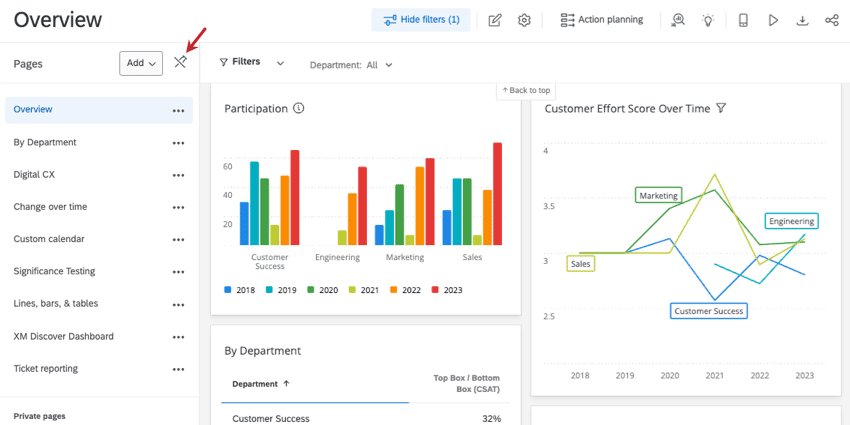
It’s suitable for larger teams needing advanced statistical tools to manage feedback across the company. Qualtrics’ capabilities also mean a steeper learning curve and higher cost for a small business than other tools.
How businesses use Qualtrics:
Create an introductory survey with up to 500 responses and see a summary of the results (Free plan)
Use advanced logic, like randomizing choices or requiring responses, to improve data quality (Free plan)
Analyze open-ended text comments, identify topics and perform sentiment analysis without manual reading (using Text iQ on paid plans)
Build and share dashboards to report on key metrics across the business (paid plans)
Integrate with enterprise systems like Adobe to connect feedback data with operational data (paid plans)
While Qualtrics offers a functional free plan for basic surveys, its core strength lies in its premium offerings (like advanced analytics features). It’s a powerful tool – likely more than most small businesses need for day-to-day feedback.
Note: Qualtrics integrates with Pipedrive through the Qualtrics API. You’ll need a developer to build the connection so that survey responses automatically create deals and trigger workflows.
8. UserVoice
UserVoice is a product feedback management system. It helps software companies capture, organize and prioritize feature requests from their customer base.
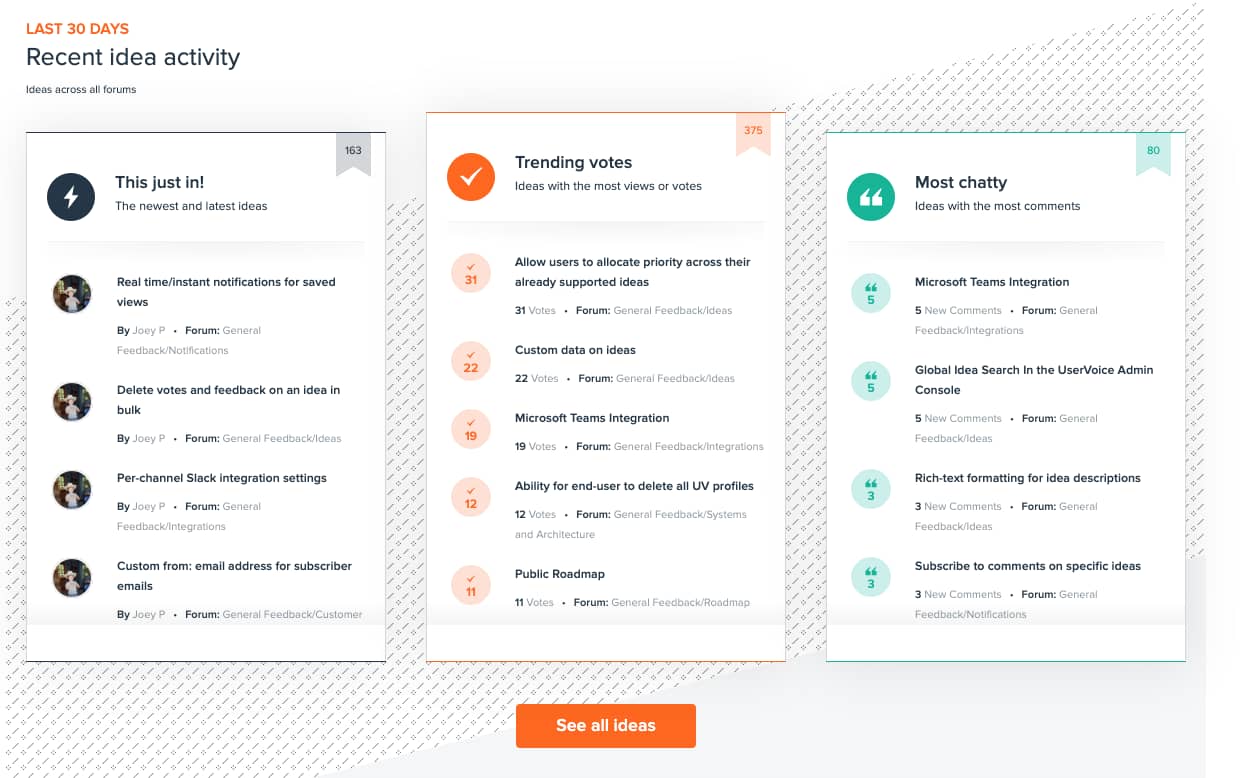
It’s useful for product teams that want to manage customer ideas and communicate their product roadmap. Instead of tracking requests in spreadsheets, UserVoice provides a central hub for users to submit and vote on ideas.
How businesses use UserVoice:
Collect and track feature ideas and bug reports through an in-app widget (all plans)
Create a public feedback portal where users can see, discuss and vote on ideas submitted by others (all plans)
Analyze feedback from specific customer segments, such as filtering ideas from high-value accounts (Premium plan)
Communicate new product updates directly to the users who requested a particular feature (Premium plan)
Integrate with tools like Jira or Azure DevOps to link customer feedback directly to development tasks (Premium plan)
UserVoice is a specialized tool for making product decisions. It’s ideal for SaaS businesses focused on building a user-driven roadmap, rather than general customer satisfaction surveys for small companies.
Note: UserVoice integrates with Pipedrive through Zapier and Make. Users adding new suggestions create deals or activities for your team to follow up on in Pipedrive’s CRM.
9. Hotjar
Hotjar is a customer behavior analytics tool that helps you understand how customers use your site. It offers heatmaps, visitor recordings, form analytics and feedback polls:
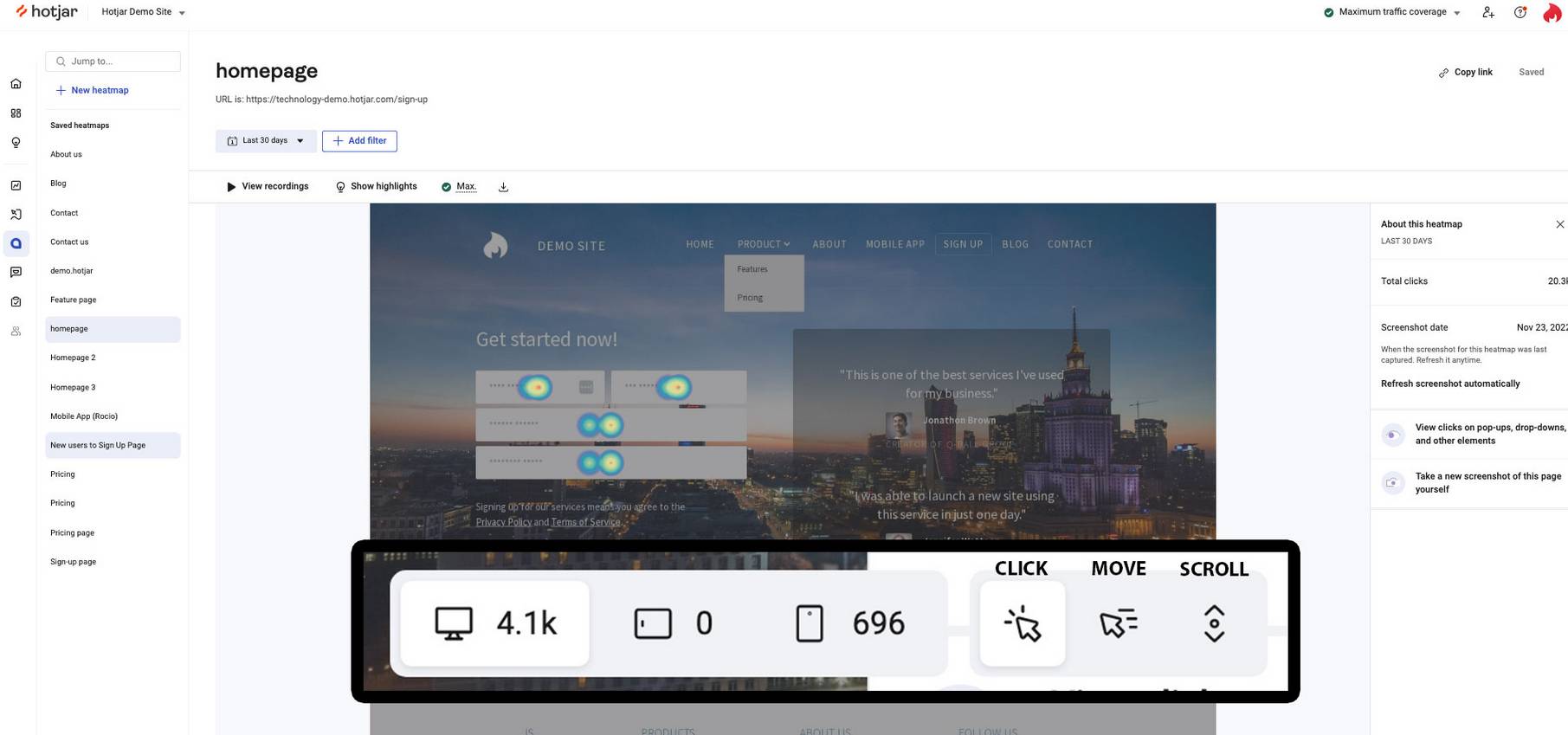
Hotjar is valuable for marketers, UX designers and product managers who want to see how users behave, rather than just reading survey responses.
Heatmaps show customer interactions as visual feedback (like clicks and scrolling patterns), helping you find friction points and usability issues.
How businesses use Hotjar:
Create unlimited heatmaps and session recordings with 35 daily sessions (Free Basic plan)
Set up feedback widgets and collect up to 20 monthly survey responses (Free Basic plan)
Track up to 100 daily sessions and use basic filtering options (Plus plan)
Get unlimited customizable surveys and integrations with up to 500 daily sessions (Business plan)
Use advanced analytics, Hotjar’s custom API and collaboration tools (Scale plan)
Hotjar provides deeper insights into user behavior that traditional surveys can’t capture, with a free plan for small websites. The pricing increases as your business grows, and some advanced features are only available on higher-tier plans.
Note: Integrating Pipedrive and Hotjar through Zapier helps sales teams understand which website interactions led to customer feedback. You can update deals in Pipedrive when Hotjar creates new feedback responses or recordings.
10. Canny
Canny is a customer feedback management tool. It creates a central hub where customers can submit feature requests, vote on ideas and track product development from suggestion to completion.
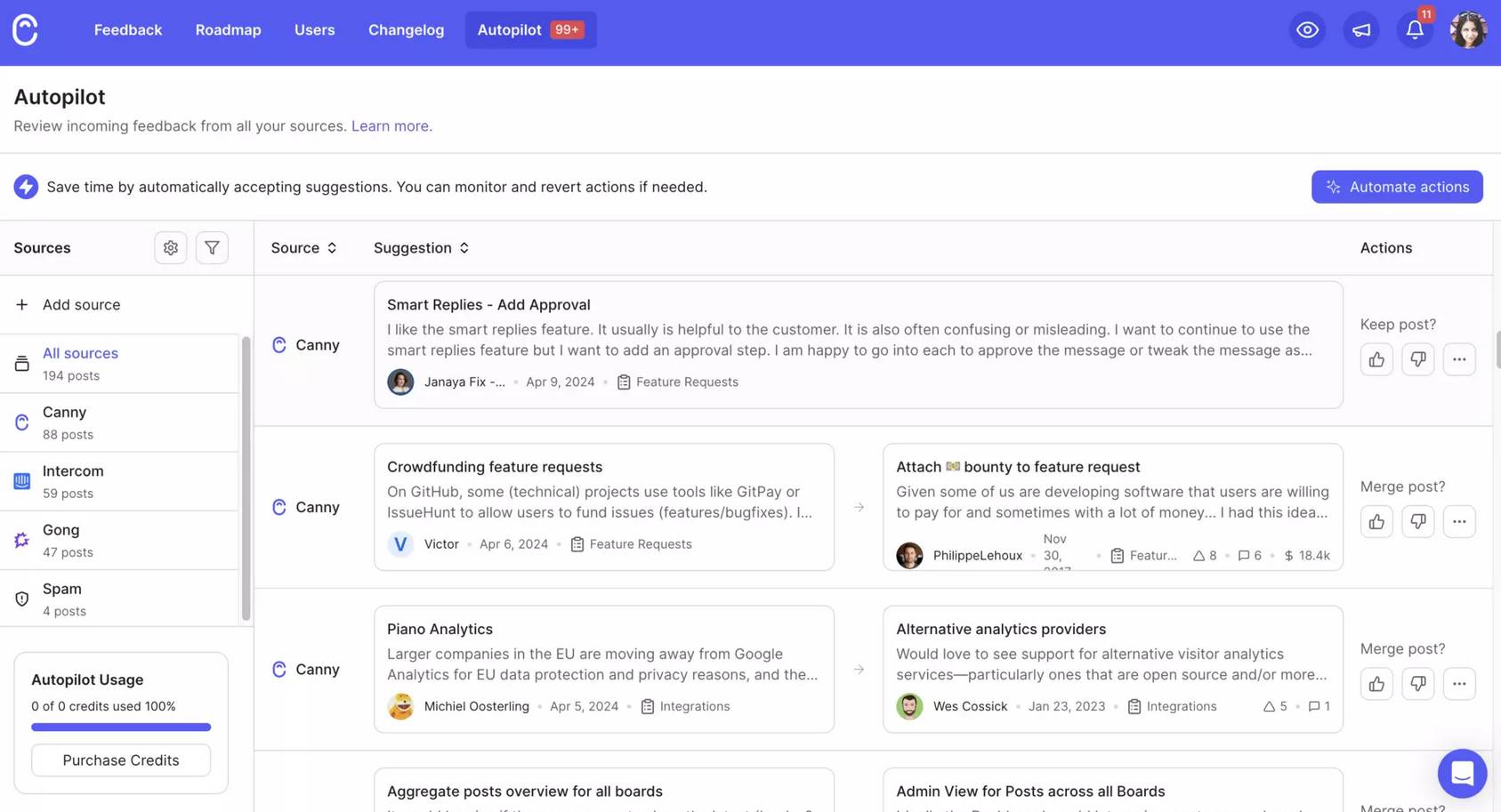
Instead of managing feedback through emails and support tickets, Canny puts all customer input in one place.
How businesses use Canny:
Collect feedback in a public portal where users can vote on ideas (all plans)
Capture feedback from customer conversations using Autopilot AI, which finds feedback in chats, calls and reviews (all plans)
Create custom domains and statuses to match your brand and workflow (Core plan and above)
Integrate with project management tools like Jira and Slack to sync feedback with development tasks (Pro plan)
Build private feedback boards for internal teams and set up advanced user permissions (Pro plan)
Canny is suitable for B2B SaaS companies that want to build products based on customer ideas. It offers a free plan for small teams, but pricing scales quickly as user engagement grows.
Note: Canny integrates with Pipedrive through Zapier. When users submit feedback, it creates activities in Pipedrive for your sales team to follow up with prospects.
11. Mention
Mention is a social media monitoring and brand listening tool that tracks conversations about your business on the web and social media platforms. It helps companies monitor their reputation by finding mentions of their brand, products and keywords.
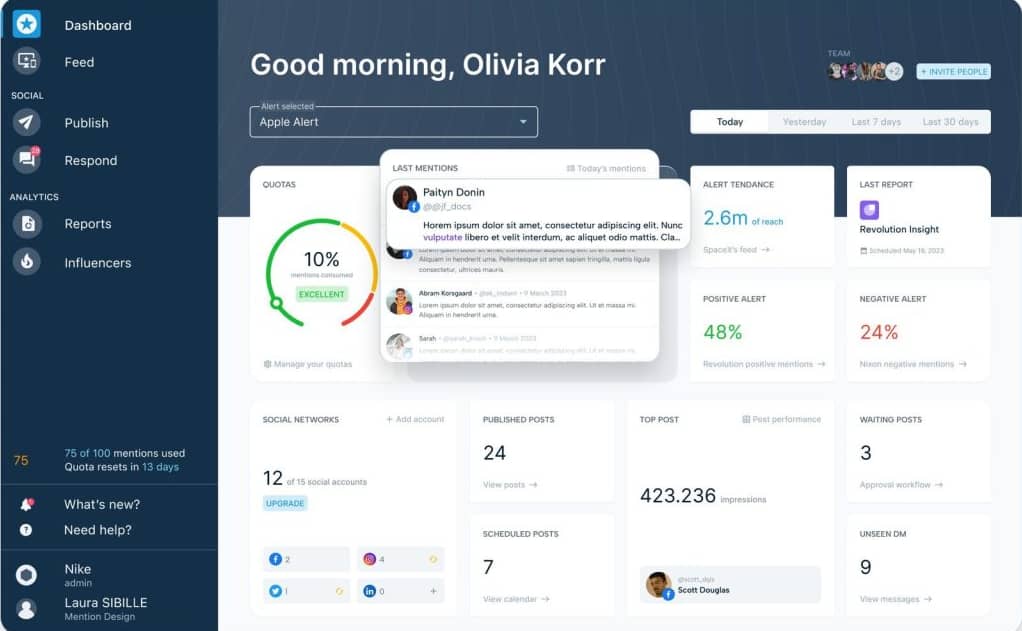
The platform analyzes mentions from social networks, news websites, blogs, forums and review sites. It gives businesses a complete picture of their online presence.
How businesses use Mention:
Set up keyword alerts to monitor brand mentions, competitor analysis and industry discussions across social media and web sources
Create advanced search queries to filter results and exclude irrelevant mentions
Analyze sentiment and track key metrics like reach, volume and engagement to measure brand health and campaign impact
Generate reports and dashboards to visualize pain points and gather insights for stakeholders
Mention offers custom pricing for your needs and scale, making it suitable for businesses of various sizes. It makes sense for marketing professionals who must track their company’s online reputation.
Note: Mention integrates with Pipedrive through Zapier. When the platform captures a relevant new brand mention, users can add a task or note to an existing deal.
How to use customer feedback tools
Customer feedback tools work best when they’re part of a connected system rather than standalone solutions.
Here’s how to get the most value from these platforms and integrate them with your sales and marketing processes.
1. Ask for feedback at the right moments
Timing matters when collecting customer feedback. Knowing how to ask customers is crucial, but getting it at the right moment increases the customer’s chance to reply.
Try to send surveys immediately after key interactions, such as purchases, support tickets or sales demos, when the experience is fresh in customers’ minds.
Most CRM tools let you automate feedback requests so your team can send them at the right moment. For example, in Pipedrive, you can set up workflows that send feedback requests when deals move to “Won” status or when you mark activities complete.
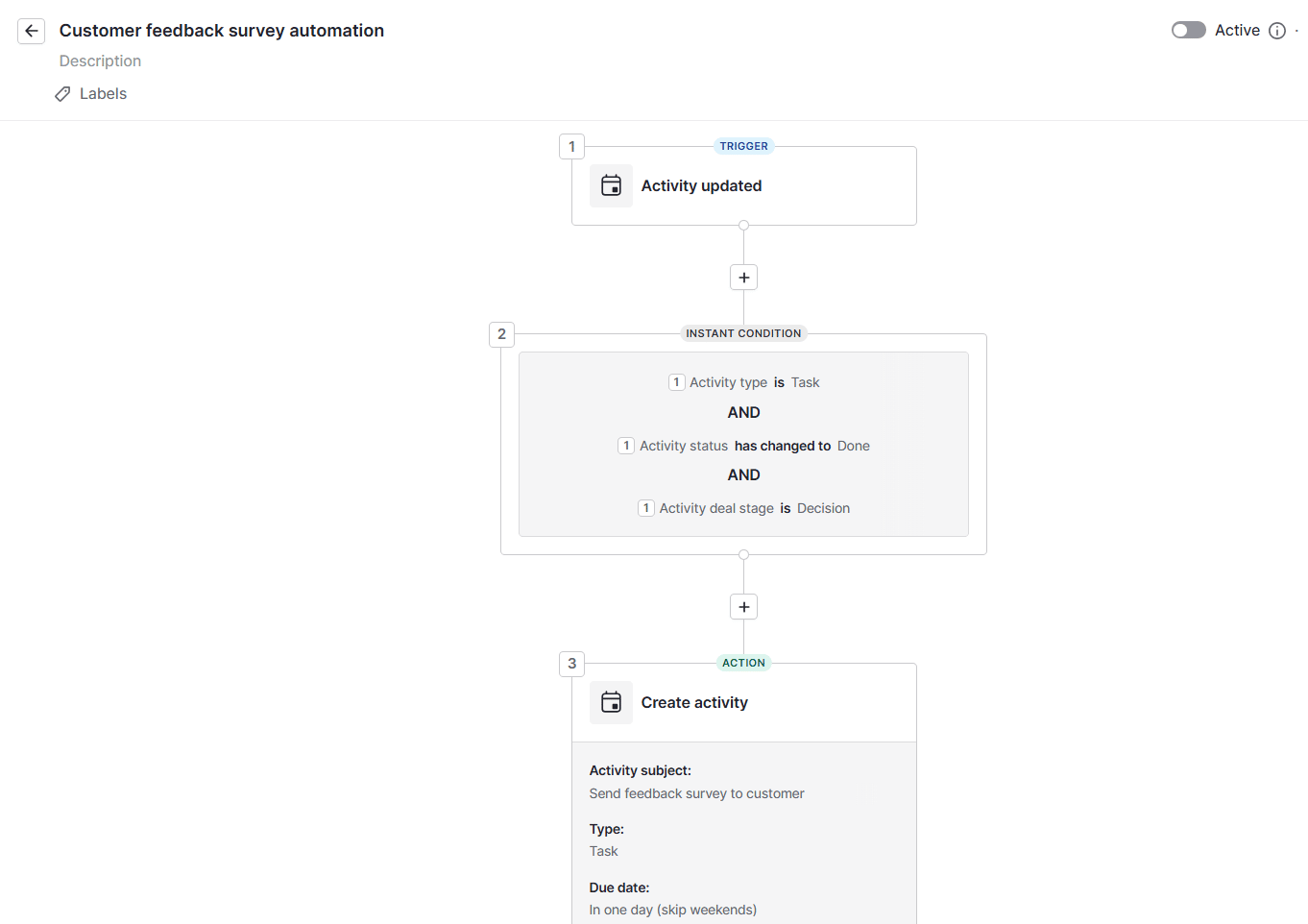
You can also create email sequences that wait a certain amount before sending, so customers have enough time to experience your product.
Pipedrive’s workflow automation builder makes this simple with drag-and-drop triggers and conditional logic that lets you customize timing and create an integrated helpdesk solution.
2. Keep surveys short and focused
Short surveys improve response rates and provide higher-quality data. Stick to 3–5 questions that relate to your business goals and avoid asking about everything at once.
Here’s an example of a straightforward feedback form:
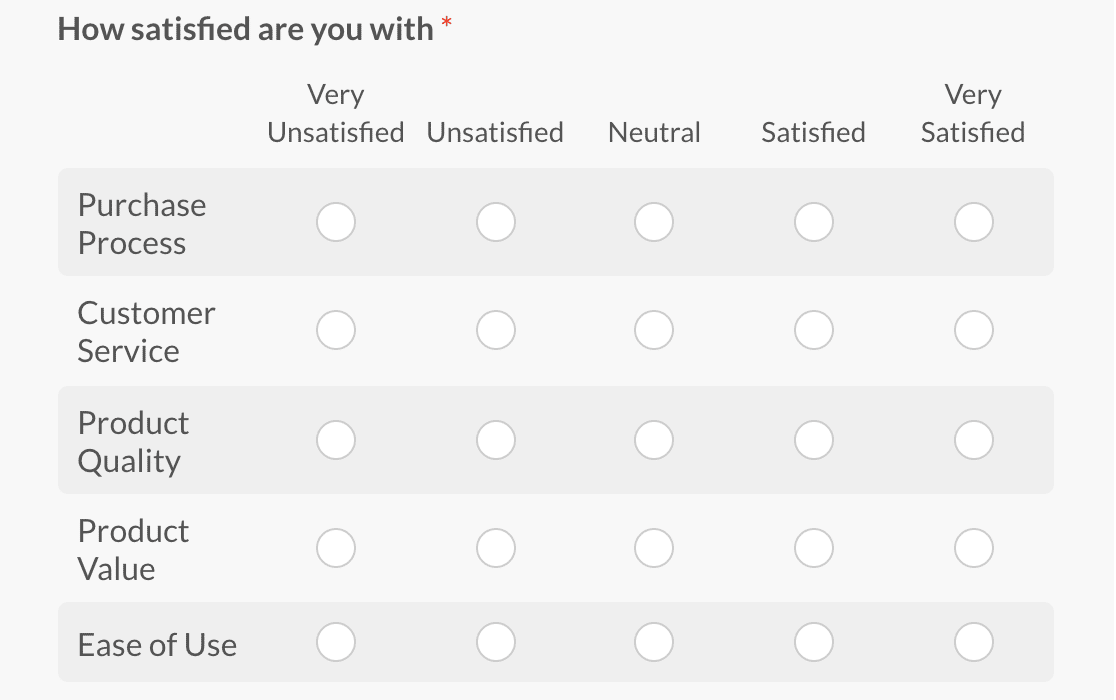
Ask your main questions using a scale, then give customers a way to provide additional feedback if they wish to.
Using a mix of rating scales and open-ended questions gives you both quantitative and qualitative data. Rating scales give you measurable data you can track over time, while open-ended questions reveal the actionable insights behind customer opinions.
Feedback tools let you create survey templates for different purposes, like post-purchase satisfaction or feature requests. Choose the proper survey to send based on the customer’s interaction with your business.
Pipedrive in action: With a CRM, you can track feedback from collection to implementation. For example, Document360’s CEO, Saravana Kumar, has highlighted Pipedrive’s usefulness for customer feedback:
“Pipedrive has helped us to streamline and automate our sales process to serve a huge volume of prospects and respond to customers’ queries for better customer service.”
Using Pipedrive, you can log responses as customer records so your team sees feedback history during conversations.
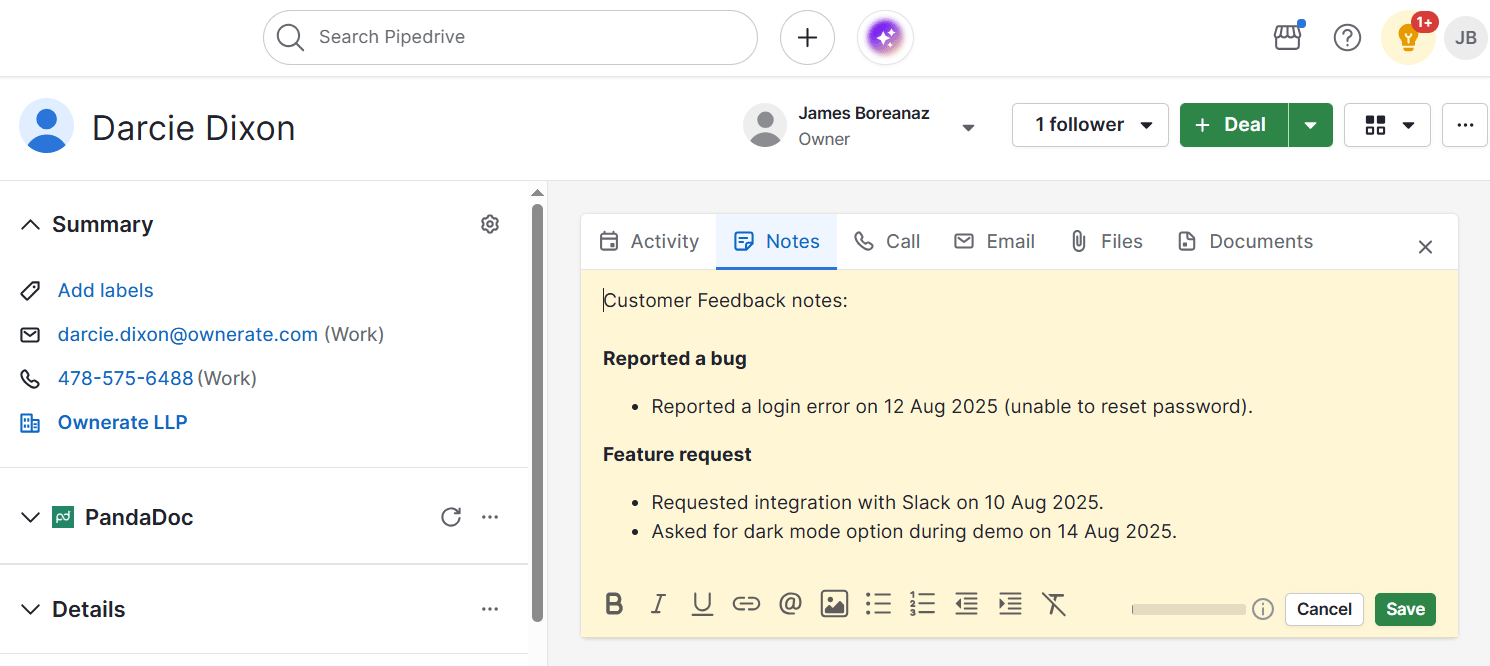
The platform’s pipeline stages help you track feedback status and set up automated reminders to follow up with customers after implementing their suggestions.
Turn Maybe Into Yes With These Killer Follow Up Email Templates
Final thoughts
Customer feedback tools help you understand customers’ thoughts, so you can improve your products and boost retention.
Choose a tool that works where your customers spend their time. Focus on your most significant knowledge gaps, then connect the feedback to your CRM to create follow-up tasks for your sales team.
Start a 14-day free trial with Pipedrive and see how much easier it is to capture customer feedback and turn those valuable insights into sales growth.





